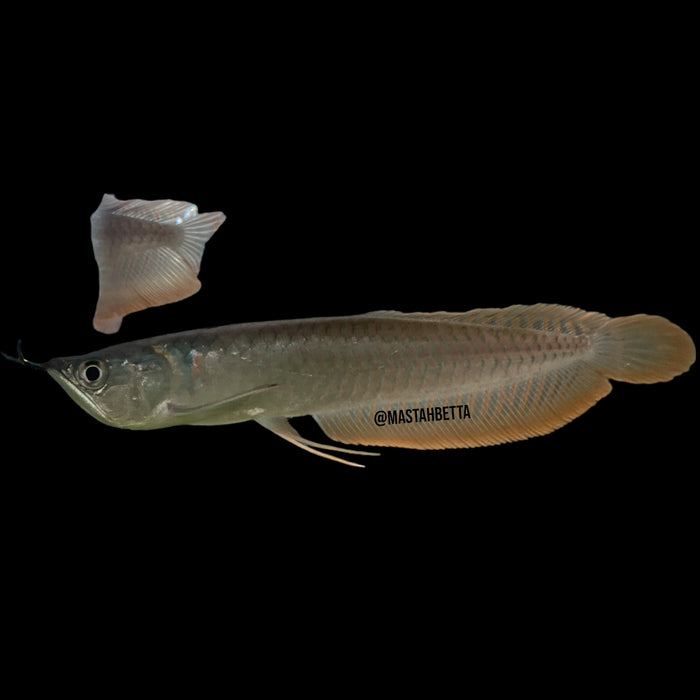
Silver Arowana
Silver Arowana for sale Online
Silver Arowana for sale Hawaii
Silver Arowana for sale near me

Silver Arowana for sale Online
Silver Arowana for sale Hawaii
Silver Arowana for sale near me
Name: Silver Arowana
Max Size: Up to 36 inches (90 cm)
Recommend pH: 6.0-7.5
Recommended Temperature (°F): 75-82°F (24-28°C)
Diet: Silver Arowanas are carnivorous and primarily feed on small fish, insects, and crustaceans in their natural habitat. In the aquarium, they should be offered a varied diet that includes high-quality pellets, frozen or live foods such as small fish, shrimp, crickets, and worms. Providing a balanced diet is essential for their health and growth.
Temperament: Silver Arowanas are predatory fish and can be aggressive towards smaller tank mates. They are best suited for large, species-specific aquariums or with other large, aggressive fish. Due to their size and territorial nature, it is important to provide ample space and hiding places to reduce stress and potential aggression.
Schooling or Non-Schooling Fish: Silver Arowanas are non-schooling fish. They are solitary by nature and prefer to swim alone in their territory.
Possible types of tank mates: Silver Arowanas are best kept with other large, aggressive fish that can withstand their territorial behavior. Tank mates may include large cichlids, catfish, and other similarly sized predatory fish. Avoid keeping them with small or peaceful fish that may become prey or targets of aggression.
Behavior: Silver Arowanas are known for their sleek, silver-colored body and impressive size. They have a long, streamlined shape and powerful jaws, which they use to capture their prey. These fish are skilled jumpers and are known to leap out of the water to catch insects or small prey. In the aquarium, it is important to provide a tight-fitting lid or cover to prevent them from escaping. Silver Arowanas are also known for their intelligence and curious nature. They may interact with their owners and exhibit interesting behaviors like surface gulping or "playing dead" to ambush prey.
Fun Fact: Silver Arowanas are renowned for their unique ability to breathe air using a specialized organ called the labyrinth organ. This adaptation allows them to extract oxygen from the air at the water's surface, enabling them to survive in oxygen-depleted environments or even out of water for short periods. It is fascinating to observe their occasional jumps to the water's surface to gulp air, which is an essential part of their natural behavior.
Perhaps the best store on island to get freshwater fish. They have a huge variety, including higher end freshwater fish (discus, puffers, flowerhorns , oddballs, ect) I’ve stocked a few tanks with their fish. They quarantine well and keep it real on how their fish are doing in shop.
Mr. Ali
Had a great experience here. I was looking for a unicorn/alicorn betta and spoke with the owner, Josh, about it. I ended up using his fish importing services to import a fish from Jakarta, and he brought in a few more white opaque or unicorn type half moon bettas too, to add to the variety in store. I got a sneak peak of the store while it was shut down for one week for a proper quarantine of its new fish. The owner knows his fish and keeps them healthy. A very different experience from a Petco or PetSmart! A Petco employee even recommended I go here for more unique betta fish. Note that they carry other types of fish too, plus Aquatic plants and some aquarium equipment. Pictured are some of the giant bettas, the alicorn betta, and i believe a beautiful ram.
Fawn B.
Wonderful shop with lots of variety. Has the most unique selection of fish on the island, and at a reasonable price! Staff is friendly and very helpful when we have questions or concerns. Love coming here and seeing the jokes around the store. Also, Vinnie!
Ian H.
The owner, Josh, is not just knowledgeable about the fish, but also plants and tank issues. I am new to fish tanks and he has been extremely helpful in answering my questions and offering suggestions to make my experience easier. Parking is a bit tricky, but certainly worth it.
Mark M.
They have rare plants you can't find at most places. Got lucky we got a few; my husband is happy. This is one of his favorite places. They get pretty busy, so be patient. The staff are very helpful.
Mr. Chin
Our online catalog is stocked with a wide variety of fresh water fish and Plants!
{"one"=>"Select 2 or 3 items to compare", "other"=>"{{ count }} of 3 items selected"}